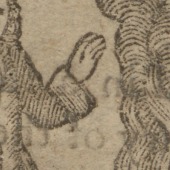The trial and execution of the three unfortunate men, that were executed between the 2 lodges on the Castle-Hill, Norwich, on Saturday April 12th 1834: one for an attempt to murder, and two for arson
Norwich: G. Stewardson, Magdalen-Street, [1834]
Many broadsides gave what purported to be a full and detailed account of legal trials and the fate of criminals and their victims. As with the modern popular press, however, they did not always tell an unbiased story. The case of Gilpin Reynolds is particularly interesting. This account makes his execution look disproportionate to the damage caused by the fire. Reports from the Norwich Mercury on 29 March 1834, however, provide more details.
Reynolds was exposed as one of a gang who had committed several arson attacks in the area. The gang operated by night but on the evening in question several men were watching for poachers in fields around the village. These witnesses gave evidence disproving Reynolds’ account of his movements. The most dramatic evidence against Reynolds was collected by the land agent for the farm in question, who found footprints in the mud at the scene of the crime, then cut out the dried footprint in the mud (complete with a large piece of earth attached) and produced it in court. It was found to match Reynolds’ footwear exactly, down to the marks of repairs and the pattern of the nails in the sole.
The Norwich Mercury account of the execution of the three men provides a more personal account than this broadside: that Gilpin was survived by his pregnant wife and one child, and that finally on the day before his execution he confessed that he had in fact committed the crime. The image is a stock image used to illustrate several executions at Norwich Castle; compare the image used for the account of the trial of Richard Knockolds.
Broadsides.B.83.7
Not on display in physical exhibition








